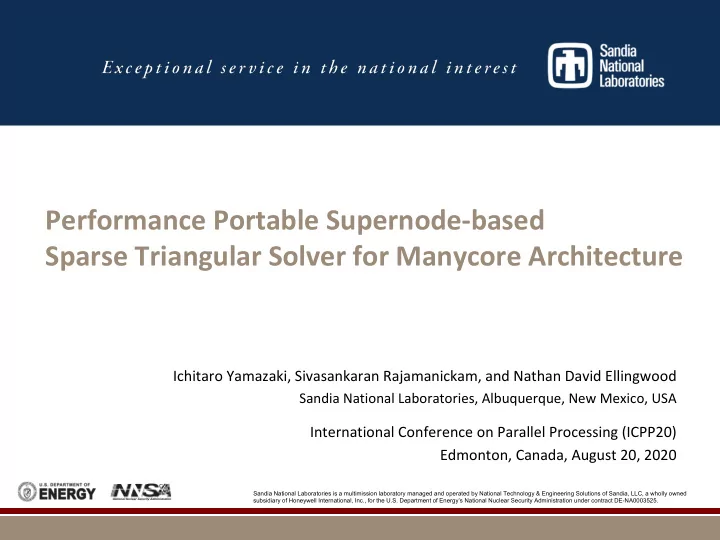

Performance Portable Supernode-based Sparse Triangular Solver for Manycore Architecture Ichitaro Yamazaki, Sivasankaran Rajamanickam, and Nathan David Ellingwood Sandia National Laboratories, Albuquerque, New Mexico, USA International Conference on Parallel Processing (ICPP20) Edmonton, Canada, August 20, 2020 Sandia National Laboratories is a multimission laboratory managed and operated by National Technology & Engineering Solutions of Sandia, LLC, a wholly owned subsidiary of Honeywell International, Inc., for the U.S. Department of Energy’s National Nuclear Security Administration under contract DE-NA0003525.
Background important kernel in many applications, but challenging to parallelize § § Sparsity structure may limit the parallel scalability focus on particular cases where each process uses sparse direct solve § § SIERRA-Structural Dynamics (SIERRA-SD): distributed-memory domain-decomposition based linear solver that uses a local direct solver and applies SpTRSV ∽ 10 4 times for each factorization § Low Mach fluid simulation: multigrid preconditioner that uses local direct solver on a coarse grid and potentially as a smoother study two algorithmic variants § § Supernode/block based level-set scheduling to exploits hierarchical parallelism § Partitioned inverse to transform SpTRSV into a sequence of SpMV 1/10
Triangular solve with level-set scheduling [Anderson & Saad’89] Dense triangular solve computes each solution element § in sequence through backward/forward substitution For a sparse triangular matrix, multiple independent § elements can be computed at each step Level-set scheduling finds a independent elements § (e.g., using DAG) , and computes these elements in parallel at each level 2/10
Supernode-based level-set scheduling Sparsity often limits the available parallelism § lots of levels with small number of tasks at each level § (e.g., tri-diagonal matrix) We exploit the block structure in the matrix § direct factorization leads to triangular matrices § with the block structure called supernodes merge columns with a similar sparsity structure § into a singe block column these columns in a supernode leads to the chain § We used supernode-based level-set scheduling § reduces the number of levels § batched kernels for hierarchical parallelism § § all the leaf-supernodes in parallel § threaded kernels (e.g., BLAS/LAPACK) on each block column 3/10
Partitioned inverse with supernode-based level-set Dense triangular solve with the diagonal block § is fundamentally sequential (chain) Invert diagonal block to replace TRSM with GEMV § for computing the solution blocks, and then use another GEMV to update the RHS § Use batched GEMV to update all solutions update with single gemv with gather/scatter of x in parallel with a single kernel launch Apply the inverse of the diagonal blocks to the corresponding off-diagonal blocks § to merge these two batched GEMV calls into one Partitioned inverse [Alvardo, Pothen, Schreiber,93] based on level-set partition of supernodes § It transforms SpTrsv into a sequence of SpMVs § Instead of batched GEMVs, we can use a single SpMV call § § no operation with explicit zeros, but lose block structure 4/10
Implementation Kokkos & Kokkos-kernels § Portable to different manycore architectures § Some more details in the paper § Data structure § CSR/CSC, with explicit zeros to form supernodal § blocks for dense operations, e.g., TRSM+GEMV Interfaced with SuperLU & Cholmod packages § Experiment setups SuperLU to factor the matrix with METIS ordering § Performance on an NVIDIA V100 and P100 GPU § gcc compiler version 6.40 or 5.40 and nvcc 10.1 or 10.0 § Performance comparison with NVIDIA’s CuSPARSE, cusparseDcsrsv2_solve § Use level-set scheduling cusparseDcsrsv2_analysis with CUSPARSE_SOLVE_POLICY_USE_LEVEL § 5/10
SIERRA-SD matrix (n=27k) number of blocks Lots of small blocks in the beginning and a fewer larger blocks at the end § Merging block columns with the same sparsity pattern reduce the number of levels and § increase the compute intensity per level 6/10
Performance results with SIERRA-SD on V100 Default uses a standard device-level kernel (e.g., CuBLAS) on each block § Speedups using team-level or batched kernels § § Further speedup with inversion (up to 8.7x) Same solution accuracy using all the approaches § 7/10
Performance results with SIERRA-SD on P100 Varying, but significant, speedups for different sizes of matrices § Kernel-launch time can become significant § 8/10
Performance results with SuiteSparse matrices P100 V100 Performance depends on § number of levels and sizes of supernodes 9/10
Final remarks SpTRSV is an important kernel in many applications, but a challenge to parallelize § We studied two algorithmic variants where sparse direct factorization is used § Supernode/block based SpTRSV exploits hierarchical parallelism § Partitioned inverse transforms SpTRSV into a sequence of SpMV § We implemented using Kokkos and Kokkos-kernels § Portable to different manycore architectures § Some performance results on CPUs in the paper § We show performance results with SIERRA-SD (C. Dohrmann) § Up to 8.3x speedup over CuSPARSE on V100, and 17.5x using partitioned inverse § Further extensions § Performance improvements (reducing setup time, improving kernel performance, reducing kernel launch costs) § Interface with other packages including ILU § § It is available from Kokkos-kernels and Trilinos packages https://github.com/kokkos/kokkos-kernels § https://github.com/trilinos/Trilinos § 10/10
Recommend
More recommend